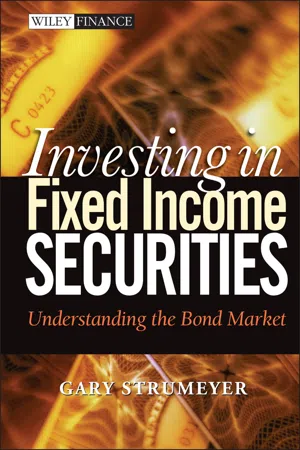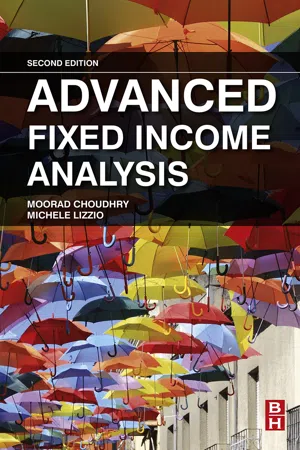Default Risk
Default risk refers to the likelihood that a borrower will be unable to meet their debt obligations. It is a key consideration for lenders and investors when assessing the creditworthiness of a business. Factors such as financial stability, market conditions, and industry performance can all influence the level of default risk associated with a particular entity.
5 Key excerpts on "Default Risk"
- eBook - ePub
Investment Valuation
Tools and Techniques for Determining the Value of any Asset, University Edition
- Aswath Damodaran(Author)
- 2012(Publication Date)
- Wiley(Publisher)
...This is the case, for instance, when you lend to a business or buy a corporate bond; the borrower may default on interest and principal payments on the borrowing. Generally speaking, borrowers with higher Default Risk should pay higher interest rates on their borrowing than those with lower Default Risk. This section examines the measurement of Default Risk and the relationship of Default Risk to interest rates on borrowing. In contrast to the general risk and return models for equity, which evaluate the effects of market risk on expected returns, models of Default Risk measure the consequences of firm-specific Default Risk on promised returns. While diversification can be used to explain why firm-specific risk will not be priced into expected returns for equities, the same rationale cannot be applied to securities that have limited upside potential and much greater downside potential from firm-specific events. To see what is meant by limited upside potential, consider investing in the bond issued by a company. The coupons are fixed at the time of the issue, and these coupons represent the promised cash flow on the bond. The best-case scenario for you as an investor is that you receive the promised cash flows; you are not entitled to more than these cash flows even if the company is wildly successful. All other scenarios contain only bad news, though in varying degrees, with the delivered cash flows being less than the promised cash flows. Consequently, the expected return on a corporate bond is likely to reflect the firm-specific Default Risk of the firm issuing the bond. Determinants of Default Risk The Default Risk of a firm is a function of two variables...
- eBook - ePub
- Frank J. Fabozzi, Frank J. Fabozzi(Authors)
- 2012(Publication Date)
- Wiley(Publisher)
...Under this definition, a delay in repayments, restructuring of borrower repayments, and bankruptcy, which constitute default events, will fall under credit risk. In addition to this, the mark-to-market loss of a bond resulting from a change in the market perception of the issuer to service the debt in future is also attributed to credit risk. This manifests itself in the form of a widening of the credit spread of the security in question against a risk-free asset, such as the Treasury bond, of similar maturity. The fluctuations in the credit spread between the two securities reflect views on the intrinsic creditworthiness of the issuer of the defaultable security. The key determinants of credit risk at the security level include probability of default (PD) of the issuer, that is, the probability that the issuer will default on its contractual obligations to repay its debt; recovery rate given that the issuer has defaulted; and rating migration probabilities, that is, the extent to which the credit quality of the issuer improves or deteriorates as expressed by a change in the probability of default of the issuer. The following sections discuss in greater detail these determinants of credit risk for corporate issuers, and wherever relevant, methods commonly employed to estimate them will be indicated. Probability of Default Assessments about an issuer's ability to service debt obligations play a fundamental role in establishing the level of credit risk embedded in a security. This is usually expressed through the default probability that quantifies the likelihood of the issuer not being able to service the debt obligations. Since probability of default is a function of the time horizon over which one measures the debt servicing ability, it is standard practice to assume a one-year time horizon to quantify this. In general, the approaches used to determine default probabilities at the issuer level fall into two broad categories...
- eBook - ePub
- Peter Christoffersen(Author)
- 2011(Publication Date)
- Academic Press(Publisher)
...12. Credit Risk Management This chapter introduces credit risk, which can be defined as the risk of loss due to a counterparty's failure to honor an obligation. Default Risk, which is a key element of credit risk, introduces an important source of nonnormality into the portfolio distribution. We first introduce the Merton model to help us understand default of a single counterparty. Default Risk has an important effect on how corporate debt is priced, but Default Risk will also impact the equity price. We build on the single-firm Merton model to develop a factor model of credit portfolio risk. The portfolio model provides a framework for computing credit Value-at-Risk. Finally, the chapter introduces credit default swaps, which give a market-based view of Default Risk. Keywords: Default, recovery, Merton model, Vasicek distribution, credit VaR, credit default swaps. 1. Chapter Overview Credit risk can be defined as the risk of loss due to a counterparty's failure to honor an obligation in part or in full. Credit risk can take several forms. For banks credit risk arises fundamentally through its lending activities. Nonbank corporations that provide short-term credit to their debtors face credit risk as well. But credit risk can be important not only for banks and other credit providers; in certain cases it is important for investors as well. Investors who hold a portfolio of corporate bonds or distressed equities need to get a handle on the default probability of the assets in their portfolio. Default Risk, which is a key element of credit risk, introduces an important source of nonnormality into the portfolio in this case. Credit risk can also arise in the form of counterparty default in a derivatives transaction. Figure 12.1 illustrates the counterparty risk exposure of a derivative contract. The horizontal axis shows the value of a hypothetical derivative contract in the absence of counterparty Default Risk...
- eBook - ePub
Investing in Fixed Income Securities
Understanding the Bond Market
- Gary Strumeyer(Author)
- 2012(Publication Date)
- Wiley(Publisher)
...It reflects the market’s determination of the relative value of that bond versus other possible investments. Any changes made to that rate will directly, and inversely, lead to changes in the market value of the bond. Since the market value changes daily for most liquid bonds, it is the most easily observed of all risks. As the yield increases the price of the bond decreases, and vice versa. The magnitude of the change in price for a given change in the yield is quantifiable, and is the subject of much research and the underpinning of certain portfolio and trading strategies. Fortunately, interest rate risk and its effects on bond prices are very well understood. Metrics like DV01, modified duration, and convexity are standard bond market calculations and are discussed in Chapter 2. CREDIT OR Default Risk The second most important risk in bond investing is credit risk, the risk that the issuer of a fixed income security will not have the financial wherewithal to repay the debt at maturity. This may involve a bankrupt corporation, municipality, or even a country. However, an investor does not necessarily have to wait until maturity to feel the effect of a “credit event.” An issuer experiencing financial difficulties may face the possibility that its bonds’ credit rating will be downgraded by one of the major rating agencies, such as Standard & Poor’s or Moody’s Investors Service. What does it mean to have one’s bonds downgraded? If the issuer of the bonds has elected to have its debt rated by one of the agencies, that agency will analyze the company’s ability to pay the coupons when they come due and to pay the final par amount at maturity. The agency will use the company’s balance sheet, income statement, measurements of free cash flow, statement of changes in financial position, and any other relevant disclosures in its determination of the financial health of the issuer...
- eBook - ePub
- Moorad Choudhry, Michele Lizzio(Authors)
- 2015(Publication Date)
- Butterworth-Heinemann(Publisher)
...Chapter 8 The Default Risk of Corporate Bonds Abstract This chapter reviews the notion of Default Risk illustrating the concepts of spread risk and several benchmark spreads used to measure the yield spread of corporate bonds compared to the government bonds. The second part of the chapter describes the two main categories of credit risk models, structural approach and reduced-form approach. The first one treats the main theoretical models that estimate the credit risk according to the movement of the underlying asset like Merton, Black and Cox, Longstaff and Schwartz and Leland. The second one includes models that estimate the spread risk giving relevance on the default probability, recovery rate and debt value like Fons, Jarrow-Lando-Turnbull, Duffie and Singleton and Mandan and Unal. Keywords Credit risk Yield spread Default Risk Spread duration Structural approach Reduced-form approach Chapter Contents 8.1 Corporate bond default spread risk 156 8.1.1 Spread risk 156 8.1.1.1 Benchmark spread 157 8.1.1.2 Spread duration 158 8.1.2 Spread risk and government bond yields 160 8.2 Default Risk and default spreads 160 8.2.1 The theoretical default spread 160 8.2.2 The default spread in relation to the outright government bond yield 162 8.3 Modeling the credit risk 164 8.3.1 Structural approach 164 8.3.1.1 Merton’s model 164 8.3.1.2 Black and Cox’s model 166 8.3.1.3 Longstaff and Schwartz’s model 167 8.3.1.4 Leland’s. model 168 8.3.2 Reduced-form approach 169 8.3.2.1 Fons’ model 169 8.3.2.2 Jarrow, Lando and Turnbull’s model 170 8.3.2.3 Duffie and Singleton’s model 172 8.3.2.4 Madan and Unal’s model 172 8.4 Web site models 173 References 173 In the companion volume to first edition of this book, part of the Fixed Income Markets Library, we looked at the range of corporate bond instruments that are held by investors. Institutions are interested in holding non-government bonds because of the higher yield that these bonds offer, relative to government bonds...




